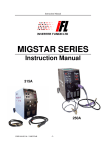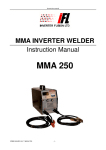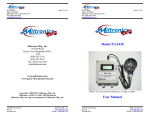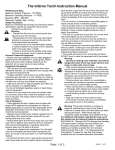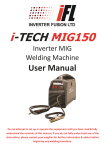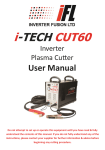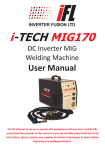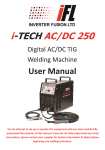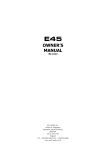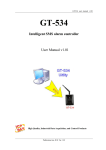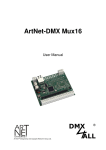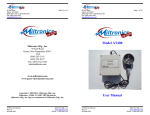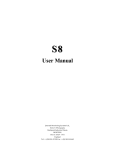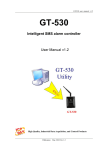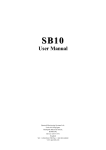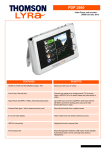Download PLASMA CUTTER - Inverter Fusion Ltd
Transcript
Instruction Manual PLASMA CUTTER Instruction Manual PLASMA CUT 40 USER MANUAL * PLASMA CUT 40 -1- Instruction Manual CONTENTS GUARANTEE………………………………………………………………………………….. …3 INTRODUCTION……………………………………………………………………………….. ..3 Warning and Safety Precautions………………………………………………………………3-5 PLASMA…………………………………………………………………………………………...5 Plasma Defined…………………………………………………………………………. …...5 Voltage Regulation……………………………………………………………………………6 Thermal Protection...................................................................................................... 6 Duty Cycle .................................................................................................................. 6 Input Power……………………………………………………………………………………6 TECHNICAL DATA .......................................................................................................... 6 INSTALLATION ............................................................................................................... 7 Operating Environment ............................................................................................... 7 Input Cable Connection .............................................................................................. 7 Torch Connection........................................................................................................ 7 TORCH ASSEMBLY ........................................................................................................ 7 Torch Assembly Procedure......................................................................................... 7 OPERATION .................................................................................................................... 8 To Begin ..................................................................................................................... 8 Cutting ........................................................................................................................ 8 Stand-off Cutting ......................................................................................................... 8 Piercing....................................................................................................................... 8 MAINTENANCE ............................................................................................................... 9 TROUBLESHOOTING……………………………………………………………………….10-11 DIAGRAM.………………………………………………………………………………………...11 WARRANTY…………………………………………………………………………………..12-13 USER MANUAL * PLASMA CUT 40 -2- Instruction Manual GUARANTEE We give our unreserved guarantee that the Inverter Welding and Cutting Power Source series comply with IEC60974 international safety standard. Maintenance for one year since the date of purchase. INTRODUCTION This manual contains descriptions, operating instructions and basic maintenance procedures for the Plasma Cut 40 machine. A complete understanding of the characteristics and capabilities of this equipment will assure the steady operation for which it was designed. WARNING • Do not change torch components without disconnecting the machine from the mains power supply. • Only qualified persons should install, operate, maintain, and repair this unit. • During operation, keep everybody, especially children, away. • CUTTING can cause fire or explosion. • Hot metal and sparks blow out from the cutting arc. The flying sparks and hot metal, hot work piece, and hot equipment can cause fires and burns. Check and be sure the area is safe before doing any cutting. • Remove all flammables within 35 ft (10.7 m) of the cutting arc. If this is not possible, tightly cover them with approved covers. • Do not cut where flying sparks can strike flammable material. • Be alert that sparks and hot materials from cutting can easily go through small cracks and openings to adjacent areas. • Watch for fire, and keep a fire extinguisher nearby. • Be aware that cutting on a ceiling, floor, bulkhead, or partition can cause fire on the hidden side. • Do not cut on closed containers such as tanks or drums. • Connect work cable to the work as close to the cutting area as practical to prevent cutting current from traveling long, possibly unknown paths and causing electric shock, sparks, and fire hazards. • Do not use plasma cutter to thaw frozen pipes. • Never cut containers with potentially flammable materials inside − they must be emptied and properly cleaned first. • Do not cut in atmospheres containing explosive dust or vapors. • Do not cut pressurized cylinders, pipes, or vessels. • Do not cut containers that have held combustibles. • Wear oil-free protective garments such as leather gloves, heavy shirt, cuff less trousers, high shoes, and a cap. • Do not locate unit on or over combustible surfaces. USER MANUAL * PLASMA CUT 40 -3- Instruction Manual • Remove any combustibles, such as a butane lighter or matches, from your person before doing any cutting. Touching live electrical parts can cause fatal shocks or severe burns. The torch and work circuit are electrically live whenever the output is on. The input power circuit and machine internal circuits are also live when power is on. Plasma arc cutting requires higher voltages than welding to start and maintain the arc (200 to 400 volts DC are common), but also uses torches designed with safety interlock systems which turn off the machine when the shield cup is loosened, or if tip touches electrode inside the nozzle. ELECTRIC SHOCK • Do not touch live electrical parts. • Insulate yourself from work and ground using dry insulating mats or covers big enough to prevent any physical contact with the work or ground. • Do not touch torch parts if in contact with the work or ground. • Turn off power before checking, cleaning, or changing torch parts. • Disconnect input power before installing or servicing this equipment • Lockout/ tag out input power according to OSHA CFR • Check and be sure that input power cord ground wire is properly connected to ground terminal in disconnect box or that cord plug is connected to a properly grounded receptacle outlet − always verify the supply ground. • When making input connections, attach proper grounding conductor first. • Frequently inspect input power cord for damage or bare wiring − replace cord immediately if damaged. • Turn off all equipment when not in use. • Inspect and replace any worn or damaged torch cable leads. • Do not wrap torch cable around your body. • Ground the work piece to a good electrical (earth) ground if required by codes. • Use only well-maintained equipment. Repair or replace damaged parts at once. • Wear a safety harness if working above floor level. • Keep all panels and covers securely in place. • Do not bypass or try to defeat the safety interlock systems. • Use only torches specified in Owner’s Manual. • Keep away from torch tip and pilot arc when trigger is pressed. • Clamp work cable with good metal-to-metal contact to work piece (not piece that will fall away) or worktable as near the cut as practical. • Insulate work clamp when not connected to work piece to prevent contact with any metal object. SIGNIFICANT DC VOLTAGE exists in inverter power sources AFTER the removal of input power. • Turn Off unit, disconnect input power, check voltage on input capacitors, and be sure it is near zero (0) volts before touching any parts. • On inverter power sources, failed parts can explode or cause other parts to explode when power is applied. Always wear a face shield and long sleeves when servicing inverters. USER MANUAL * PLASMA CUT 40 -4- Instruction Manual EXPLODING PARTS can cause injury. • Sparks and hot metal blow out from the cutting arc. Chipping and grinding cause flying metal. FLYING SPARKS can cause injury. • Wear approved face shield or safety goggles with side shields. • Wear appropriate body protection to protect skin. • Wear flame-resistant ear plugs or ear muffs to prevent sparks from entering ears. • Arc rays from the cutting process produce intense visible and invisible (ultraviolet and infrared) rays that can burn eyes and skin. ARC RAYS can burn eyes and skin. • Wear face protection (helmet or shield) with a proper shade of filter lenses to protect your face and eyes when cutting or watching. ANSI Z49.1 (see Safety Standards) suggests a No. 9 shade (with No. 8 as minimum) for all cutting currents less than 300 amperes. Z49.1 adds that lighter filter shades may be used when the arc is hidden by the work piece. As this is normally the case with low current cutting, the shades suggested in Table 1 are provided for the operator’s convenience. • Wear approved safety glasses with side shields under your helmet or shield. • Use protective screens or barriers to protect others from flash, glare and sparks; warn others not to watch the arc. • Wear protective clothing made from durable, flame-resistant material (leather, heavy cotton, or wool) and foot protection. NOISE: can damage hearing. • Use approved earplugs or earmuffs if noise level is high. • Warn others nearby about noise hazard. PLASMA Plasma Defined Plasma cutters work by sending a pressurized gas, such as air, through a small channel. In the center of this channel, you'll find a negatively charged electrode. The electrode is at the center, and the nozzle is just below it. The swirl ring causes the plasma to turn rapidly as it passes. When you apply power to the negative electrode, and you touch the tip of the nozzle to the metal, the connection creates a circuit. A powerful spark is generated between the electrode and the metal. As the inert gas passes through the channel, the spark heats the gas until it reaches the fourth state of matter. This reaction creates a stream of directed plasma, approximately 30,000 F (16,649 C) or more and moving at 20,000 feet per second (6,096 m/sec), that reduces metal to vapor and molten slag. The plasma itself conducts electrical current. The cycle of creating the arc is continuous as long as power is supplied to the electrode and the plasma stays in contact with the metal that is being cut. The cutter nozzle has a second set of channels. These channels release a constant flow of shielding gas around the cutting area. The pressure of this gas flow effectively controls the radius of the plasma beam. NOTE! This machine is designed to use only compressed air as the “gas”. USER MANUAL * PLASMA CUT 40 -5- Instruction Manual Voltage Regulation The Automatic Voltage Compensation circuit prevents voltage load from exceeding maximum in accordance with the main technical data sheet and shortening the life of the machine. Thermal Protection The thermal protection circuits will engage if unit exceeds duty cycle. This will cause the machine to stop working. The indicator will be lit on the front of the machine. The fan will most likely continue to run until unit cools down. When it reaches an acceptable temperature, it will operate again. Duty Cycle Duty cycle is the percentage of on time (measured in minutes) in a 10-minute period in which the machine can be operated continually, in an environment of a specified temperature. Exceeding duty cycle ratings will cause the thermal overload protection circuit to become energized and shut down output until the unit cools to normal operating temperature. Continual exceeding of duty cycle ratings can cause damage to the machine. TECHNICAL DATA DATA CUT- 40 Single phase 230V RATE INPUT POWER (KVA) 4.4 NO -LOAD VOLTAGE (V) 250 RATE OUTPUT CUR (A) 40 RATE OUTPUT VOLTAGE (V) 110 DUTY CYCLE (%) 30 CUT THICKNESS (MM) 13 WEIGHT (KG) 9 DIEMENSIONS (MM) USER MANUAL * PLASMA CUT 40 327*250*155 -6- Instruction Manual INSTALLATION Torch Connection Operating Environment Make sure working area is well ventilated. The unit is cooled by an axial-flow fan, which provides airflow through the back panel over the electronics and out the machine cover vents. If unit is operated without sufficient cooling the duty cycle will be greatly reduced. Input Cable Connection Every machine includes a primary input power cable capable of handling the input voltage and current for this unit. If the unit is connected to power that exceeds the required voltage, or is of the incorrect phase, serious damage will be incurred and warranty will become void. This machine operates on 230 volts singlephase 50/60hz. Proper input voltage can be determined by observing the labels next to the power cord strain relief and will be labeled 230V. Service must be fused for at least 40mps. Connect the Torch to the inverter by screwing the airline fitting on the end of the torch to the torch connector fitting on the front of the machine. Secure by tightening with wrench slightly. DO NOT OVER TIGHTEN! TORCH ASSEMBLY Ensure the machine is disconnected from the mains before changing torch components. Torch Assembly Procedure Position the torch with the shield cup facing upward and unscrew and remove the shield cup from the torch head assembly (The shield cup holds the tip, ceramic swirl ring, and electrode in place). Neutral (Ground) wire is yellow with a green stripe or solid green. This wire must be connected to the “ground” terminal of the power plug you use. Remove the tip, ceramic swirl ring, and electrode. If using an extension cord, make sure that it meets or exceeds the following recommendations: Install and hand tighten the shield cup until it is seated on the torch head. If resistance is felt when installing the cup, check the threads and parts configuration before proceeding. For 230 VAC Service conductor thickness Up to 50 ft. 14 AWG Up to 100 ft 12 AWG Note: The input current required to produce the same output power is inversely proportional to the input voltage. Example: If the machine draws 22 amps @ 220 volts it will draw 44 amps @ 110 volts to produce the same power output. USER MANUAL * PLASMA CUT 40 -7- Install the electrode, ceramic swirl ring, and tip. Replace worn parts, as necessary. Note: On some torches that do not have reversible electrodes it will be necessary to secure the electrode by slightly tightening with pliers to assure reliable electrical connection. Instruction Manual OPERATION Piercing To Begin For piercing, position the tip approximately 1/8" (3.2 mm) above the work piece. Angle the torch slightly to direct sparks away from the torch tip and operator. Initiate the pilot arc and lower the tip of the torch until the main cutting arc transfers, sparks start. Start the pierce off the cutting line on the scrap piece or template and then continue the cut onto the cutting line. Hold the torch perpendicular to the work piece after the pierce is complete and continue cutting as desired. Clean spatter and scale from the shield cup and the tip as soon as possible. Turn the Power Switch to the ON position. Position yourself to where you can read the air pressure. Press the torch switch (air will exhaust from torch, adjust the air regulator to read approximately 60 to 70 pounds (PSI) and release torch switch. Note: The Air pressure has a generally acceptable range of 50 to 80 PSI. You may experiment as desired… but be careful not to lower the pressure too much as consumable damage will occur. Secure ground clamp to work piece. Connect clamp to main part of work piece, not the part being removed. Quality Cuts CUTTING Drag Cutting Position torch tip slightly above work piece, press torch switch and lower torch tip toward work piece until contact is made and cutting arc is established. After cutting arc is established, move the torch in the desired direction keeping the torch tip slightly angled, maintaining contact with the work piece. Avoid moving too fast as would be indicated by sparks radiating from the topside of work piece. Move the torch just fast enough to maintain sparks concentration at the underside of the work-piece and making sure the material is completely cut through before moving on. Adjust drag speed as desired/required. Stand- off Cutting In some cases, it may be beneficial to cut with the torch tip raised above the work-piece approximately 1/16" to 1/8” to reduce material blowback into the tip and to maximize penetration of thick material cuts. An example of "stand-off cutting" would be used when penetration cutting or gouging operation is being performed. You can use this technique when cutting sheet metal to reduce the chance of splatter-back tip damage. USER MANUAL * PLASMA CUT 40 -8- Dross (slag) is the excess material that spatters and builds up on the underside of the work-piece as you cut. Dross occurs when the operating procedure and technique is less than optimal. It will require practice and experience to obtain cuts without dross. Although less than optimal cuts will contain dross, it is relatively easy to remove by breaking it off using pliers or chipping off with a chisel or scraping or grinding the finished cut as needed and is generally only a minor inconvenience. A combination of factors contributes to the buildup of dross. They include; material type, material thickness, amperage used for the cut, speed of the torch across the work-piece, condition of the torch tip, input line voltage, air pressure, etc. Generally there is an inversely proportional relationship between output current and speed of cut. Do not use more output current than is necessary and adjust speed of cut toward minimizing dross buildup on underside of cut. Experiment with adjusting current and speed to minimize dross. Instruction Manual MAINTENANCE 1. Each Use Each time you use the plasma cutter; check the Torch, Tip/Nozzle, Electrode, Swirl Ring and Shield Cup. Inspect Torch for any wearing, cracks or exposed wires. Replace or repair before use. A worn Torch Tip/Nozzle contributes to reduced speed, voltage drop and crooked cuts An elongated or oversized orifice indicates a worn Tip/Nozzle. The face of the electrode should not be recessed more than 1/8”. Replace if worn beyond this point. If the Shield Cup does not go on easily, check the threads. 2. Weekly Check for proper fan operation Blow or vacuum dust and dirt out of the entire machine and the air filter. . USER MANUAL * PLASMA CUT 40 -9- Instruction Manual TROUBLESHOOTING PROBLEM Torch will not come on Sparks are shooting upward Instead of down through the Material. CAUSE Power Switch Off SOLUTION Turn Power Switch to the On Position Air supply is compromised Another indication of this is a more green flame Check air supply. Work piece Ground Attach to work piece or to steel table with Clamp not attached. work piece securely clamped to table. Plasma Torch is not Increase current. piercing the material. Torch may too far away from stock Decrease the distance of your torch to stock Material may not be grounded properly Check connections for proper ground. Travel speed too fast Beginning of cut not completely pierced Dross build-up on parts of cuts Arc stops while cutting Insufficient penetration Possible connection problem Tool/Material building up heat Reduce speed Check all connections Allow material to cool then continue cut. Cutting speed too slow or Current to high. Increase speed and/or reduce current until dross is reduced to minimum. Worn torch parts Cutting speed too slow Inspect and repair or replace worn parts. Increase speed until problem solved Torch is too high, away from material Lower torch to recommended height Worn torch parts Inspect and repair or replace worn parts Workpiece ground cable disconnected Cutting speed too fast Connect Workpiece Ground Clamp to workpiece or steel table. Slow travel speed Torch tilted too much Adjust tilt. Metal too thick Several passes may be necessary Worn torch parts Inspect and repair or replace worn parts USER MANUAL * PLASMA CUT 40 - 10 - Instruction Manual Consumables wear quickly Exceeding unit capability Material too thick, increase angle to prevent blow back into torch tip. Excessive Pilot arc time Do not pilot for more than 5 seconds. You can also start with torch in contact with metal or within 1/16” of metal. Improperly assembled torch Inadequate air supply, pressure too low. Faulty air compressor See section titled “Torch Assembly” Check air filter, increase air pressure. Check air compressor operation and make sure input air pressure is at least 100 PSI If you have any problems in setting up or operating, please first consult this manual. If you are still having difficulties after reading this manual, please contact Inverter Fusion Ltd direct. Front View Back View Indicator light Power Switch Torch Air Hose Connection Current Output Torch terminal Switch Connection USER MANUAL * PLASMA CUT 40 Power Cable - 11 - Air pressure hose Instruction Manual PRODUCT WARRANTY September 2010 This limited warranty supersedes all previous Inverter Fusion Limited warranties and applies to sales of Inverter Fusion Limited equipment in the UK. Warranty Subject to the following terms and conditions, Inverter Fusion Limited warrants to the original retail purchaser that new Inverter Fusion Limited equipment sold in the UK is free of defects in material and workmanship at the time of its despatch from Inverter Fusion Limited for the warranty period advertised for the product at the time of sale. Within the warranty period as listed, Inverter Fusion Limited will repair or replace any warranted parts or components that fail due to such defects in material or workmanship, provided the warranty has been registered at the time of purchase. Inverter Fusion Product Warranty shall not apply to: • Consumable items and accessories supplied by Inverter Fusion Limited but manufactured by others. These items will be covered by the manufacturer’s warranty, if any. • Electrodes, contactors and relays. • Equipment that has been modified or repaired in any way • Equipment that has been improperly installed, misused, improperly operated, or used in a manner that does not comply with an industry standard. • Equipment that has been used for a purpose outside the specifications for that equipment • Equipment that has not been maintained in a condition that would make it suitable for use. • Equipment which has been used in conjunction with parts or consumables which affect the equipment operation which are deemed by Inverter Fusion Ltd to be of inferior quality or no fit for that purpose In the event of a valid warranty claim being made on any Inverter Fusion Limited product, the exclusive remedies shall be, at the discretion of Inverter Fusion Limited, either the repair or replacement of the product To the extent permitted by Law, the remedies provided herein are the sole and exclusive remedies. Inverter Fusion Limited liability under this warranty shall not exceed the cost of correcting the defect. In no event shall Inverter Fusion Limited be liable for direct, indirect, special, incidental or consequential damages (including loss of profit), whether based on contract, tort, or any other legal theory. USER MANUAL * PLASMA CUT 40 - 12 - Instruction Manual Any express warranty not provided herein and any implied warranty, guarantee, or representation as to the performance, and any remedy for breach of contract, tort or any other legal theory which, but for this provision, might arise by implication, operation of Law, Custom of Trade, or course of dealing, including and implied warranty or merchantability for a particular purpose, with respect to any and all equipment furnished by Inverter Fusion Limited, is excluded and disclaimed by Inverter Fusion Limited. Warranty Registration In order for any warranty to be valid, the Warranty Registration Card enclosed must be completed and returned at the time of purchase in order to register the warranty with Inverter Fusion Limited. Alternatively the warranty may be registered via the company’s website www.inverterfusion.com Warranty Claims Procedure In the event of a claim, the claimant must first contact Inverter Fusion Limited for a warranty claim authorization number. Following this, the Warranty Claim form, as printed on the reverse side of this page should be completed with all the details as requested and forwarded to Inverter Fusion Limited at the address below along with the faulty product and a copy of the original purchase receipt. The claimant will be responsible for all carriage, insurance and transportation costs in returning the product to Inverter Fusion Limited. Upon receipt and inspection of the product, if valid the product will be repaired or replaced at the discretion of Inverter Fusion Limited. In the event of a repair being required that is not considered to be a warranty issue, the claimant will be contacted for his further instruction. Following the completion of any authorized warranty claim work, the product will be returned to the original claimant at the cost of Inverter Fusion Limited. (UK Customers Only) Failure to comply with the above procedure could invalidate or delay the completion of any warranty work. Improper use, abuse or any attempt to repair the product by an unauthorized third party will invalidate any warranty claim. Inverter Fusion Ltd Heathpark Way Heathpark Industrial Estate Honiton Devon EX14 1BB USER MANUAL * PLASMA CUT 40 - 13 -













